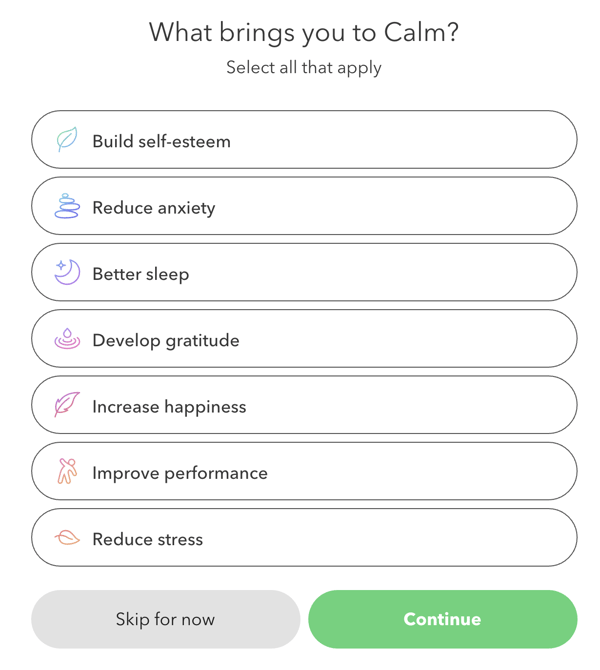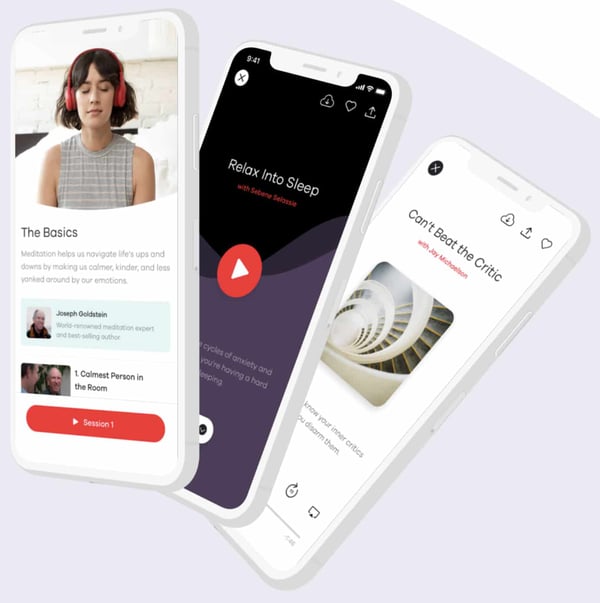Let’s get this out into the open: I bite my nails. Or at least I did. (Kinda gross, right?)
But a few summers ago, I watched as my then three-year-old son chomped down on his fingernail. That was it. The final kick in the butt I needed to see to finally stop a decades-old bad habit.
Little did I know that in my quest to stop biting my nails, I’d unlock something much bigger for myself -- both personally and professionally. It was mindfulness.
According to the folks at U-Cal Berkeley’s Greater Good Science Center, mindfulness is about "maintaining a moment-by-moment awareness of our thoughts, feelings, bodily sensations, and surrounding environment."
For me, mindfulness has helped me make better decisions, listen more, and above all, be present. Amidst the chaos of our busy, multi-screen, too-many-browser-bookmarked lives, it helps me return to a more centered self.
More and more, people are embracing both big and small mindfulness tactics. So, what can you do to get in on the goodness? I'll tell you. Here's how I met mindfulness.
Consulting a Mindfulness Expert
I knew that guided meditation and hypnosis was probably a good bet to kick the nail-biting habit.
So, I reached out to Paul Gustafson, a Boston-area consulting hypnotist. Gustafson helps people -- via guided meditation and hypnotic suggestion -- with anything from quitting smoking to overcoming a fear of flying.
I sat down with him for three, 30-minute sessions where he talked me into a deep relaxation and then, as I reached a deep meditative state, he provided guidance and suggestions for me to figuratively cut the cord of my past nail-biting behavior. From there, I kept his guided meditation recording on repeat.
“The immediate benefit of guided meditation is profound relaxation,” Gustafson told me.
“It’s impossible to be stressed or to worry while enjoying deep meditative bliss. One of the long-term benefits of meditation is that the relaxation becomes the rule rather than the exception. People who meditate are happier, and often feel less affected by the pace of day-to-day life. They’re healthier and more productive.”
Paul has become an oft-invoked name at my house. My wife, also a marketer, has gone to see him and notes that it’s been entirely transformative in finding her chi, both in and out of work. (After all, anyone with small children can attest to the need for mindfulness.)
How Mindfulness Contributes to Better Marketing
Mindfulness is a terrific asset for today’s marketers ... but you're probably wondering where the data is, right?
Well, a study conducted by INSEAD and The Wharton School of the University of Pennsylvania found that 15 minutes of mindful meditation could help a person make better decisions. That same study shows that mindfulness “can reduce confirmation bias and overconfidence, allowing decision makers to better differentiate between relevant and irrelevant information.”
This isn't the only study that points to how mindfulness can help you in the business world. More recent research suggests that 10 minutes of mindfulness each day can lower stress, improve your mood, and make you more creative.
Considering the vast information available to marketers, having a filter for the superfluous can let you focus on what’s most important and make decisions accordingly.
Gustafson has helped patients deal with stress related to dealing with a boss, or co-worker, too.
“I’ve had many clients come to me because of work-related stress. When someone repeats a stressful response to certain situations it becomes a pattern. Over time, patterns become rooted, and people feel powerless to change the situation. Guided meditation enables individuals to release and become free of unpleasant patterns," Gustafson told me.
Some companies -- like Google, Goldman Sachs, and Medtronic -- have gotten on board the mindfulness train, too.
I’ve been lucky enough to work for a company that values its employees’ approach to work, rather than just the output.
The HubSpot perk I took full advantage of while in my role was the Nap Room in the Cambridge, Mass. office.
For me, the nap room is a meditation chamber. Just 20 minutes of guided meditation -- or slow, deep breathing as the hammock gently rocks back and forth -- will clear the mind and bring a sense of focus that even the strongest cup of coffee can’t conjure.

But, unfortunately, many companies don't have a Nap Room. Some also don't take time to encourage mindfulness or positive mental health practices. If you're in this type of situation, there are still a number of ways to embrace mindfulness in any environment.
How to Practice Mindfulness and Meditation
What You'll Need
When you really need to pause, contemplate life, or navigate stress, here's a quick and simple recipe for a solid meditation session:
Mindfulness Ingredients:
- A quiet spot
- An open mind
- 20 minutes each day
Optional:
- Headphones, with guided sessions
- Popular apps for reminders or self-guided meditation
Mindfulness Tips
1. Meditate in the mornings.
Akin to the adage that a trip to the gym in the morning gives you more energy, a trip to mindfulness early in your day sets your mind up for success, too. You don’t even have to leave the comfort of your bed. Just put on the headphones as you awake.2. Or, try to meditate at night.
At the other end of the day, it’s entirely acceptable and effective to fall asleep as you meditate. If you’re using a guided meditation track, whether you’re awake or asleep, your mind is taking in the information.3. Block out time for meditation, yoga, or other mindfulness activities.
Set up a recurring daily calendar item so that others don’t cut into your “mindfulness meeting." My colleague Steve Haase has written quite a bit on meditation and mindfulness. Haase and other colleagues sit in silence for 20 minutes on Wednesday mornings to clear their minds for the day.4. Practice deep breathing.
Sometimes the biggest rewards come from the smallest of actions. Deep breathing falls into that category. Take deep breaths throughout the day when you feel overwhelmed, overstimulated, or just need to top off the mindfulness tank.5. Fight distractions while meditating.
The brain is a muscle. And, when you work out any muscle, it can be hard to try doing something that feels unnatural with it. Sitting in quiet is something that is challenging for the brain, especially when you're busy or stressed, but this is something you can train yourself to do.
For many of us, our instincts when idle -- in line at the grocery store checkout, in the elevator, at the traffic light -- are to fill the void with a few swipes of the screen. Don’t do it. In much the same way that good ideas sometimes arrive whilst in the shower, lying in bed, or even sleeping, simply being present can be the difference in finding clarity or that elusive good idea you’ve been chasing.
6. Practice mindfullness and meditation regularly.
Like any new workout, you might fail the first couple of times you try to meditate. For some, it can be surprisingly hard. And, no matter how much you feel like you've gotten mindfulness down, your mind can still slip on any given day.
Are you going to enter a state of deep bliss every time you sit down to meditate? Probably not. Your mind will wander. Just like some runs or workouts feel better than others, so do meditation sessions. No two are alike.
Mindfulness Apps and Software
While finding a quiet space and trying to clear your mind will provide a good foundation for mindfulness and meditation, there are also a number of digital aids that can ease you into a more mindful state. Here are just a few:
Headspace
Headspace is a mobile app and subscription service which allows you to stream or purchase thousands of guided meditations from mindfulness experts. When search "Best meditation apps" on Google, it appears at the top of the list on a number of blogs.
Aside from meditations, Headspace also offers sleep sounds and mindfulness workouts that people can try before going to sleep.
Although you can get a free trial for Headspace, the subscription costs $12.99 per month. At the moment, Headspace is also offering free subscriptions to those who are unemployed.
Calm
For those looking for a cheaper app, Calm (Roughly $6 a month or $70 perr year) similarly provides guided meditations, mindfulness training, and sleep sounds. The app allows a 7-day free trial before charging users.
When joining the app, you can answer a few questions about why you're looking to learn more about mindfulness and meditations. This will help the software send meditations that fit your lifestyle.
 For businesses and academic institutions that want to embrace mindfulness, managers and colleges can invest in a company Calm membership, which allows employees globally to use the app on multiple devices. This membership price is not specified on Calm's site.
For businesses and academic institutions that want to embrace mindfulness, managers and colleges can invest in a company Calm membership, which allows employees globally to use the app on multiple devices. This membership price is not specified on Calm's site.
Ten Percent Happier
If you're skeptic of meditation, but interested in learning scientifically-backed meditation practices, you can consider the paid app, Ten Percent Happier.
The app takes a realistic approach to meditation. The creators and brand admit that meditation isn't perfect, easy, or an answer to all of life's woes. However, science does prove that it can help you in some areas. The primary goal of the subscription is to make users just 10% happier.
Pricing is not directly listed on the app's website, however, a paid membership includes hundreds of guided and daily meditations, as well as access to one-on-one conversations with a meditation coach.
Ten Percent Happier offers both a free trial of the full membership and a limited free version which offers basic meditations and information, stats related to meditation performance, and daily notifications reminding you to meditate.
Sound Machines or Voice Assistants
While sound machines might offer a plethora of natural relaxing sounds or white noise that can drown out roommates or traffic outside, a voice assistant, like an Amazon Echo or Google Home, might have a number of meditation or sound related skills pre-programmed on the device. Investigate what your voice assistant or sound machine can offer and identify ways to implement these machines in your mindfulness strategy.
Benefits of Mindfulness
Still feeling skeptical about whether or not you should try mindfulness and meditation practices? I'll leave you with just a small handful of benefits to keep in mind:
1. Your mind will become more open to opportunities.
If you expect a lot from yourself, you’ve probably experienced the anxiety of your expectations actually getting in the way of success. With mindfulness, you can open yourself up to the moment. You can focus less on the eventual outcome (though mindful of that goal) and instead be present to new ideas.2. Stress-management could become easier.
Do I get worked up still? Sure (ask my wife). But more often I can find myself navigating stressful situations with a bit more grace or awareness of solutions rather than focusing on frustrations.3. Planning things on the spot might get easier.
A less cluttered, focused mind tends to provide more room for planful thought. I’ve found myself able to pull together a thoughtful response or tidy plan in less time.4. Being present can improve your outlook on life.
Take it from Bill Murray. We do our best when we’re present. But it’s not easy.from Marketing https://ift.tt/2CIaH7n


No comments:
Post a Comment